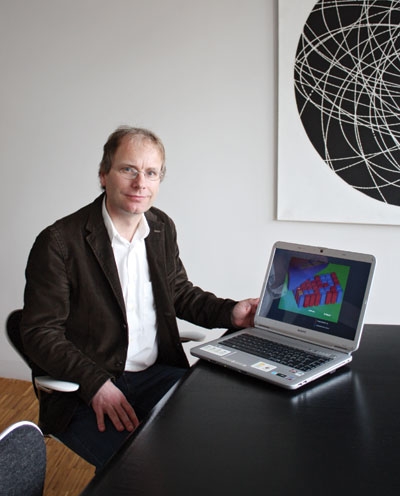
Industry News
News
Improved Finger Joints
Combining their respective strengths of computer simulation and wood and bonding technology, St. Pölten University of Applied Sciences and Holzforschung Austria plan to involve industry partners in co-operative projects to perfect their research results in practice and to make laminate lumber – a major export of Austria – a more predictably stable and economically viable option for builders.
December 2, 2011 By Colleen Cross
 Dr. Thomas Schrefl Combining their respective strengths of computer simulation and wood and bonding technology
Dr. Thomas Schrefl Combining their respective strengths of computer simulation and wood and bonding technology
Austria is the second largest manufacturer of laminated timber in Europe with annual production of one million cubic metres. Wood laminate products can consist of short, individual lengths of wood that are primarily joined together with finger jointing to produce longer wooden panels. The individual strips of wood are bonded to produce laminated wooden boards.
Dr. Thomas Schrefl, project manager and renowned simulation expert, explains the significance of the “Optwood research project” for the European timber and woodworking industry: “Finger jointing is the key technology in joining individual strips of wood into practically seamless laminated panels. The manufacture of laminated timber relies on this method. Only in this form is wood, as a construction material, capable of competing on an economic footing with other materials, such as concrete. Laminated timber currently holds a 30% to 35% share of the construction market, which is worth more than a billion euros. This market share will be lost if finger jointing is not optimized. We have now addressed this issue with an innovative, novel computer simulation process and are applying it to develop a new software solution to create optimal finger joints that meet the timber industry’s requirements in terms of standards and cost factors.”
Rather than relying on trial-and-error quality control methods and simulation methods applied only to finished products, and therefore more costly, the new computer simulation process applies the “fast boundary” element method. Using recently developed mathematical methods, the surface structure of the jointing fingers and their load distribution is calculated using integral equations on computers, which develops completely new geometrical shapes in finger jointing, where potential and feasibility can be virtually tested on the computer immediately, and without major input or expense.
Conroy Lum, wood engineering group leader, and Chunping Dai, senior scientist and researcher, at Canada’s FPInnovations’ Forintek Division, see the project’s results as a potentially useful tool in helping builders of finger joints meet high standards. They agree that, in Dai’s words, “computer models are useful for predicting the average response and reducing experimental cost,” but caution that “tests are still needed to calibrate the models and to establish the boundary of variation.”
Lum suggests the computer modeling, “may give you a good average value to start from but the issue has always been accounting for the variability, whether that be due to variations in the manufacturing or in the wood quality in and around the joints. These are random effects, which are difficult to quantify. In the end, the differences we see between grades of fingerjoined lumber are due to the variability, as opposed to the average strength . . . . The question is how much testing is required to ‘calibrate the model’ versus just trying out a profile.”
Work on the software will be complete by summer 2010. Dr. Schrefl says the two main partners will “collaborate with partners in industry for the final finessing of the software. The methods applied and the software environment will then undergo further development, and will be optimally adapted to the requirements of the timber and woodworking industry. We are open to co-operation with additional companies that are ready to mutually apply the innovative software in practice. They would benefit from cutting-edge expertise at an early stage and gain clear competitive advantages.”Optwood received funding from the Austrian Research Promotion Agency as part of the ModSim computational mathematics program being implemented by the Austrian Research Promotion Agency on behalf of the Federal Ministry for Transport, Innovation and Technology (BMVIT).
Print this page